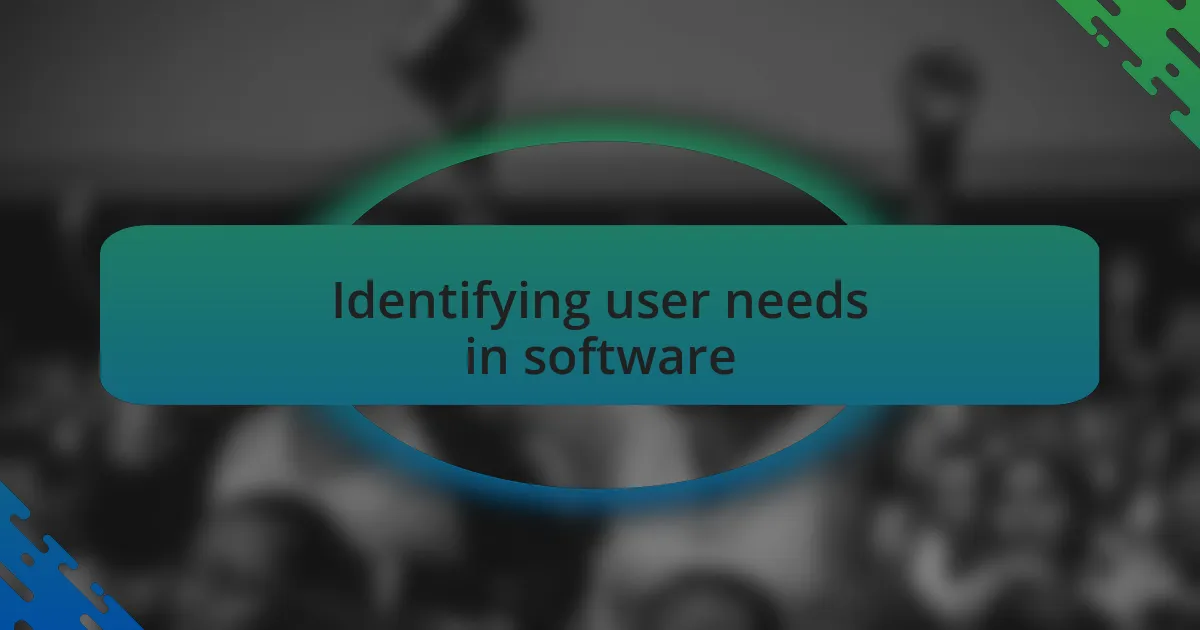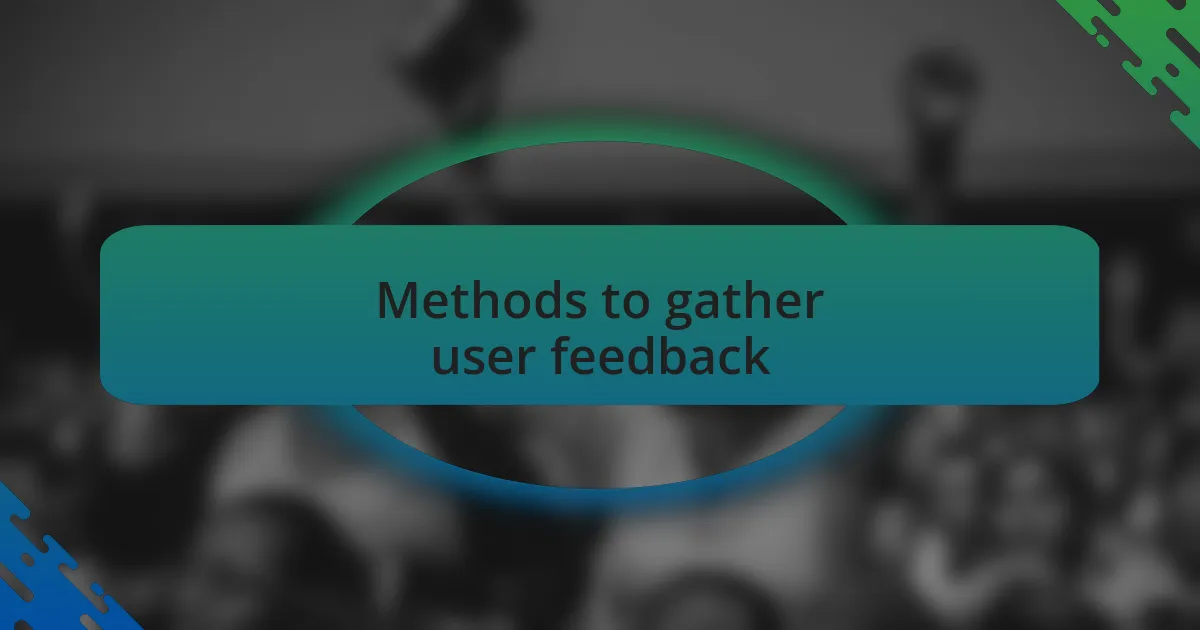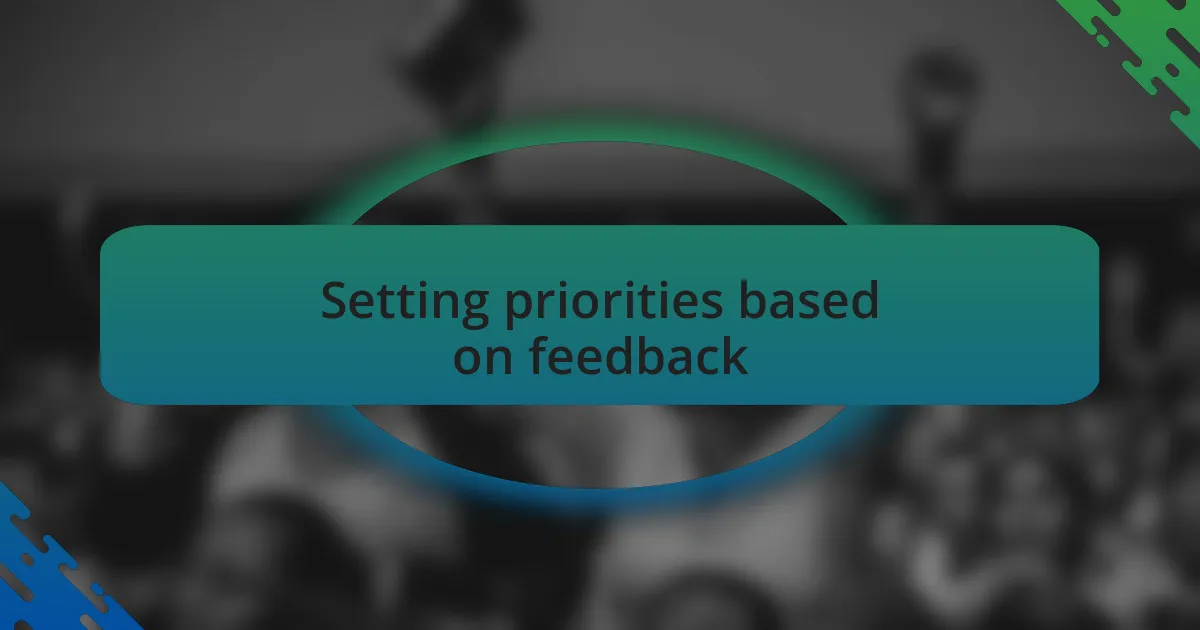Key takeaways:
- Understanding user needs is essential for effective software design, enhancing functionality, and fostering innovation through regular user feedback sessions.
- Active listening, one-on-one discussions, and ongoing reassessment of user needs are crucial for accurately identifying what users truly want.
- Collecting user feedback through methods like usability testing and engagement on social media provides valuable insights that can lead to meaningful software improvements.
- Analyzing feedback for patterns, prioritizing based on impact, and combining qualitative and quantitative data are key to making informed decisions that enhance user experience.

Understanding user needs importance
Understanding user needs is crucial in software development because it shapes the entire design and functionality of a product. I recall a project where I launched a feature based purely on my assumptions about user behavior. The result? A complete miss. Users found it confusing, which led me to question, how well do we really know those who use our software?
Digging deeper into user needs not only enhances functionality but also builds trust. When I shifted focus to regular user feedback sessions, I noticed a marked improvement in user satisfaction. Could there be a greater reward than knowing you’ve solved real pain points for your users?
Ultimately, understanding user needs fosters innovation. I’ve seen teams thrive when they prioritize these insights, using them as a foundation for creative solutions. Isn’t it fascinating how a simple shift in perspective—from “What do we want to build?” to “What do users really need?”—can spark breakthroughs that propel projects to new heights?

Identifying user needs in software
Identifying user needs in software begins with active listening. In my experience, just sitting down and talking with users opened my eyes to aspects I had never considered. I remember one meeting where a user expressed frustration about a feature they felt was overly complicated. That single conversation not only led to a redesign, but it also reinforced the idea that users often know better than we do what they want.
Surveys and questionnaires can reveal trends, but nothing beats the depth of a one-on-one discussion. I once conducted informal interviews with a group of beta testers, and the insights were invaluable. They provided feedback that’s easily overlooked in a survey, such as their emotional responses to particular features. How can we create meaningful software if we overlook their feelings and frustrations?
Finally, keeping an open mind toward evolving user needs is essential. I recall a project where the initial target audience shifted over time. By continuously reassessing and iterating based on user input, we were able to adapt and better serve our users. How often do we pause to question if what we built still aligns with what our users desire today? Regular reflection on this question can lead to powerful transformations in our software development journey.

Methods to gather user feedback
User feedback can be collected through various methods, each with its unique advantages. One technique I’ve found effective is usability testing, where I observe users navigating through the software in real-time. I remember once watching a user try to complete a task that I thought was simple. Their struggle made me rethink not only the interface but also the entire user journey – a vivid reminder of how critical it is to see users in action.
Another method I frequently use is analyzing user behavior through tools like heatmaps and session recordings. These tools allow me to see where users click, scroll, or get stuck. Once, after reviewing a heatmap, I discovered that a critical feature was barely being utilized because it was hidden from sight. This taught me that sometimes, numbers can tell a story more effectively than words.
Finally, gathering feedback through community forums and social media can’t be overlooked. I’ve often learned about user pain points in conversations that stemmed from casual remarks on these platforms. Engaging with users in such informal settings not only humanizes the feedback process but also fosters a stronger connection with the community. Have you ever stumbled upon a game-changing suggestion hidden in a casual comment? It’s these moments that remind me to always keep my ears open, even in the digital chatter.

Analyzing user feedback effectively
Analyzing user feedback effectively requires a thoughtful approach. When I sift through feedback, I always look for patterns that indicate common pain points. I remember once analyzing a batch of comments where multiple users highlighted confusion over a particular feature. This was an eye-opener for me; sometimes, a single voice in the crowd can be dismissed, but when several users express the same concern, it signals a real need for change.
Another aspect I focus on is prioritizing feedback based on its potential impact. For instance, feedback that suggests a small tweak to enhance user navigation can make a significant difference in overall user satisfaction. I once implemented a minor adjustment based on user suggestions, and the positive response was immediate—users felt more in control and engaged. Isn’t it fascinating how small changes can create a ripple effect in improving user experience?
Moreover, I find it essential to combine qualitative feedback with quantitative data. While user comments provide deep insights into emotions and frustrations, the numbers can guide decisions. I’ve integrated user satisfaction scores with the feedback I receive, allowing me to gauge not just the issues users face but also the emotional weight behind them. By understanding both the ‘why’ and the ‘what,’ I can take more informed actions that resonate with user needs and enhance engagement.

Setting priorities based on feedback
When it comes to setting priorities based on feedback, I’ve learned that it’s crucial to ask the right questions. For instance, after receiving feedback on a product feature that users found overwhelming, I organized a brainstorming session. Everyone contributed ideas, and we quickly sorted them by urgency and impact. That collaboration not only clarified our priorities but also fostered a sense of ownership among the team. Isn’t it motivating to see how collective input can steer development in a more meaningful direction?
Delving deeper into user comments has also highlighted the power of urgency in feedback. I recall a time when users were struggling with a slow loading time on a popular feature. The overwhelming consensus was clear: this needed immediate attention. By shifting team resources to tackle this issue, I noticed an immediate spike in user engagement afterward. How often have we underestimated the importance of addressing issues that users feel need instant solutions?
Additionally, I find that categorizing feedback helps clarify priorities even further. For example, I once listed user suggestions into three categories: high impact, medium impact, and low impact. Once categorized, I realized that several of the medium impact items were surprisingly quick fixes. Tackling those not only boosted user satisfaction but also made users feel heard. It’s remarkable how prioritizing feedback can lead to quick wins, reinforcing the idea that their opinions truly shape the evolution of our platform.